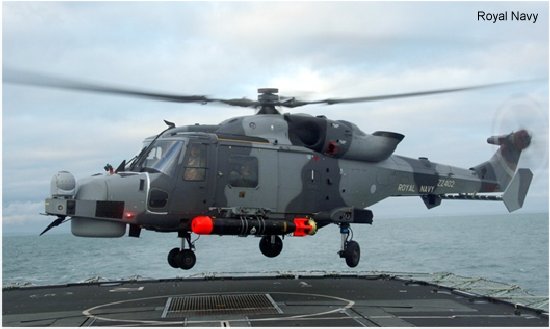
Royal Navy, January 11, 2012 - The Navy’s next-generation helicopter has begun its most extensive trials yet, joining a frigate at sea for the first time.
A prototype Wildcat – successor to the long-serving Lynx – will spend the next month flying on and off HMS Iron Duke in the Channel.
Touching down on a Royal Navy warship for the first time at sea, the Fleet Air Arm’s next-generation helicopter is beginning its most extensive trials yet.
Wildcat – successor to the trusty Lynx which has served the Navy admirably since the 1970s – will spend the next few weeks flying from HMS Iron Duke as air and ground crew lay the groundwork for front-line operations.
The Wildcat will be the mainstay of helicopter operations from Royal Navy destroyers and frigates with 28 ordered for the Fleet Air Arm.
Although the aircraft looks similar to its predecessor – with the exception of its distinctive tailplane which improves the helicopter’s stability – Wildcat’s characteristics are sufficiently different from Lynx to warrant extensive flight trials, setting the parameters within which it can safely operate.
Wildcat has gone to sea before, landing on the back of aviation training ship RFA Argus off the South Coast back in November.
And this prototype, ZZ402, paid a brief visit to Iron Duke just before Christmas, when pilots and technicians tested some of the basics – could the flight deck recovery system pull Wildcat into the hangar (yes it could), did Wildcat fit in the hangar (ditto), can it be easily refuelled and rearmed, connect up to the frigate’s command systems (affirmatives again).
Those trials were carried out with the ship stationary in Portsmouth Naval Base. For the ‘Ship Helicopter Operating Limits’ trials currently under way, Iron Duke and Wildcat have put to sea.
A team of more than 30 experts has joined the Type 23 warship for the evaluation; the ship has also been fitted with specialist instruments to record every aspect of the trials.
Initially, those will take place in Lyme Bay, before Iron Duke sails increasingly westwards, not least searching for rough weather to help define those operating limits ‘over the full envelope of operations’ (ie payloads and weights carried by Wildcat in all manner of climatic conditions).
The trials should take until around early February (and involve, among other things, Iron Duke searching for rough weather to help define those operating limits ‘over the full envelope of operations’) after which around nine months is required to analyse and evaluate all the information gathered.
A prototype Wildcat – successor to the long-serving Lynx – will spend the next month flying on and off HMS Iron Duke in the Channel.
Touching down on a Royal Navy warship for the first time at sea, the Fleet Air Arm’s next-generation helicopter is beginning its most extensive trials yet.
Wildcat – successor to the trusty Lynx which has served the Navy admirably since the 1970s – will spend the next few weeks flying from HMS Iron Duke as air and ground crew lay the groundwork for front-line operations.
The Wildcat will be the mainstay of helicopter operations from Royal Navy destroyers and frigates with 28 ordered for the Fleet Air Arm.
Although the aircraft looks similar to its predecessor – with the exception of its distinctive tailplane which improves the helicopter’s stability – Wildcat’s characteristics are sufficiently different from Lynx to warrant extensive flight trials, setting the parameters within which it can safely operate.
Wildcat has gone to sea before, landing on the back of aviation training ship RFA Argus off the South Coast back in November.
And this prototype, ZZ402, paid a brief visit to Iron Duke just before Christmas, when pilots and technicians tested some of the basics – could the flight deck recovery system pull Wildcat into the hangar (yes it could), did Wildcat fit in the hangar (ditto), can it be easily refuelled and rearmed, connect up to the frigate’s command systems (affirmatives again).
Those trials were carried out with the ship stationary in Portsmouth Naval Base. For the ‘Ship Helicopter Operating Limits’ trials currently under way, Iron Duke and Wildcat have put to sea.
A team of more than 30 experts has joined the Type 23 warship for the evaluation; the ship has also been fitted with specialist instruments to record every aspect of the trials.
Initially, those will take place in Lyme Bay, before Iron Duke sails increasingly westwards, not least searching for rough weather to help define those operating limits ‘over the full envelope of operations’ (ie payloads and weights carried by Wildcat in all manner of climatic conditions).
The trials should take until around early February (and involve, among other things, Iron Duke searching for rough weather to help define those operating limits ‘over the full envelope of operations’) after which around nine months is required to analyse and evaluate all the information gathered.
AW159 ZZ402 ( Fleet Air Arm )
See also |
AW159 Wildcat HMA2 in




